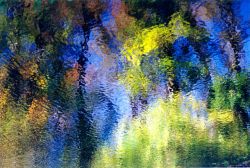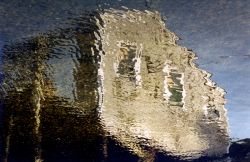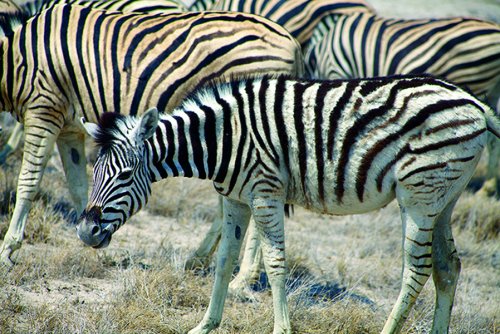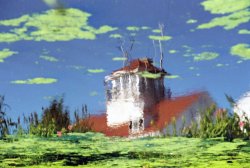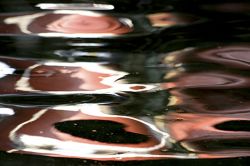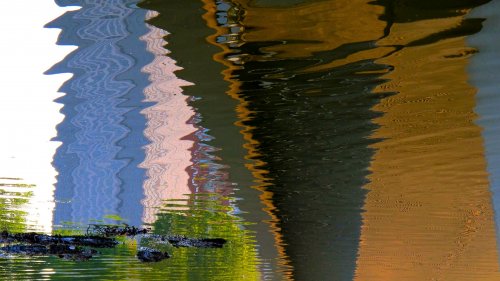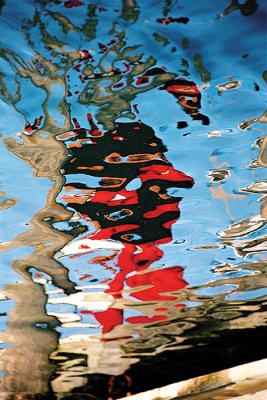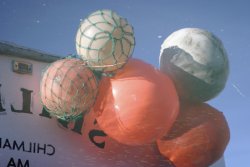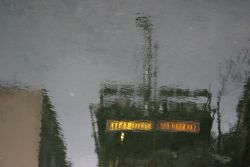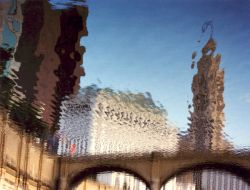
Aug, 30, 2008
Julliard Journal
The Making of an Art Exhibition: A Curator's View
written by Greta Berman
Focus on Art | by Greta Berman |  |
My
column has always been dedicated to bringing extraordinary art to the
attention of the Juilliard community, and this is no exception.
However, this time I have an additional motive. The show I discuss here
is one I have co-organized and helped plan. It will be the first
exhibition to present the work of synesthetic artists in context.
 | | Carol Steen, Clouds Rise Up, 2004 (oil on canvas-covered masonite), from the artist's collection.
(Photo by Stuart Tyson)
|
|
As
someone who teaches visual art to musicians and dancers, I have long
been fascinated by synesthesia, a term describing the involuntary
joining of the senses. Most of us assume that everyone sees and hears
things the same way we do, but synesthesia provides proof that this is
not necessarily the case. Scientists have found it difficult to study
synesthesia because of its idiosyncratic nature; there is no uniformity
in the way individual synesthetes experience colored sounds, colored
letters, or textures of music. However, the artwork and recorded
statements of numerous synesthetic artists clearly show the existence
of recurrent patterns. This discovery helps us to better understand the
entire synesthetic phenomenon, and perception in general.
The
form of synesthesia most familiar to those in the arts is “colored
hearing,” the coming together of color and musical sound. Thanks to
current and ongoing research, we now know that this is only one of more
than 54 forms that synesthesia (regarded at different times in history
as something odd, or highly desirable) can take. We still do not know
how many synesthetes there are. Just a few years ago, it was thought
that perhaps one person in 25,000 had synesthesia; today, scientists
believe it is far more common, affecting as many as one person in 100.
In
recent years, an increasing interest in synesthesia has resulted in
quite a number of exhibitions featuring “visual music.” But most of
them have dealt only with metaphorical (voluntary) rather than genuine
(involuntary) synesthesia. Several shows have also featured sound-art,
in which artists have attempted to replicate synesthesia by means of
computers.
An exhibition at McMaster Museum of Art
in Hamilton, Ontario (Canada), that runs from September 18 through
November 15 will be different. Indeed, it is the first to place
genuinely synesthetic artists in context, and examine shared
characteristics in their art. Presented in conjunction with the
university’s neuroscience department, it also examines assumptions
about art and the brain. Do synesthetic artists share common shapes,
colors, or ways of seeing? Are they consciously using their visions to
create their work? Are they aware that they might be using these
abilities creatively? How do non-synesthetes perceive images in the
work of synesthetic artists? And perhaps most challenging of all, which
artists are synesthetic?
In addition to the art of four known
synesthetes—David Hockney, Joan Mitchell, Marcia Smilack, and Carol
Steen—we are including works by Charles Burchfield, Tom Thomson,
Kandinsky, and Van Gogh. Burchfield has clearly suggested, in numerous
journal entries, that he might have been synesthetic. Thomson, well
known in Canada but not in the United States, is a new discovery for
us. We perceive elements in his work that match some in Burchfield and
other synesthetes. And Van Gogh and Kandinsky also qualify as
might-have-beens.
Hearing a recent performance of synesthetic composer Olivier Messiaen’s Des Canyons aux Étoiles
helped me to identify some commonalities that apply to visual art as
well as musical composition. In this work, the composer illustrates
musically his enchantment with the sights and sounds of Utah’s Bryce
Canyon. Especially intrigued by birdsong, he also describes the wind
and the colors of the landscape. It is no coincidence that all the
visual artists in our show also respond ecstatically in their art to
the colors, sounds, depths, and complexity of nature.
In order to
convey the canyon’s impact, Messiaen makes use of anomalous musical
techniques, including instruments played in a highly unconventional
manner. For example, the French horn uses flutter-tonguing, arpeggios,
and pitch blending; the trumpet wails, making shrill sounds; percussion
and special machines evoke wind; the piano uses the entire range of the
keyboard to produce overtones that sing out after the notes have been
played.
Likewise, synesthetic visual artists often use unusual
techniques and perspectives. Steen expresses her artistic vision by
applying oil paint with her fingers; Smilack photographs reflections
upside down when she “hears them,” and Hockney creates opera sets
according to the sound that informs his colors. Kandinsky claimed to
have discovered abstraction upon seeing one of his works wrong side up.
Synesthetes invariably manifest a multilayered, complex way of looking
at and interpreting things. In synesthetic art, both paintings and
music exploit unexpected and startling rhythms.
 | | Vincent van Gogh, Still Life With Ginger Jar and Onions, 1885 (oil on canvas), McMaster University Collection. |
|
I
thought it might be interesting to explain firsthand how a museum
exhibition like this one comes together. The planning began a year in
advance. In August 2007, the director and curator of the McMaster
Museum of Art asked Steen and me to help conceive and carry out an
exhibition in conjunction with McMaster’s department of psychology,
neuroscience, and behavior. While the museum was booked several years
in advance (as are most cultural institutions), they were able to free
up a gallery that was to have held an exhibition from their permanent
collection. We began telephone conferences and planning the exhibition
in September, and conversations and site visits have been ongoing all
year.
The theme of the exhibition is the role of synesthesia in
the creation of art, and an examination of common characteristics in
artists we know to be synesthetic (as well as a number who might be).
After coming up with the general concept, we had to compile a list of
artists, then select specific works that would best illustrate our ideas.
We had to locate the art we wanted, and then obtain the agreement of
lenders. Co-curator Steen and I made numerous visits to galleries,
artists’ studios, and museums, and we searched for pieces online as well. The job of assembling the works for the exhibit posed a number of problems in locating and acquiring the art,
as well as obtaining permissions and agreements. The financial aspect,
of course, was also a major consideration. It can be very expensive to
borrow, restore, conserve, frame, pack, and transport these pieces safely.
After
we had chosen the works and the museum had obtained the loan and
copyright agreements, Carol and I visited the university in order to
see the gallery, so that we could envision exactly how the art would be
displayed.
Next, there was the question of a catalog to document
the exhibition. We needed writers and designers to put the information
and illustrations together. The museum director was
extremely supportive, selecting a rather expensive format, for which we
asked six scholars to write essays. When the artworks arrive at the
gallery on September 9, we will install them over the next two days,
conduct a workshop, arrange for the opening, and help coordinate the
publicity.
A show that we hope will look effortless demands
hard work. We expect that the exhibition will bring about a new and
intense kind of visual thinking. In addition to exploring aesthetic
beauty, its aim is to challenge assumptions, as it is supported by
actual observation and new information. Although the show takes place
in Hamilton, Ontario, and I do not anticipate that many of you will be
able to see it in person, there will be an extensive catalog available.
The catalog will ensure that the scholarship will be accessible to many
who can’t attend, as well as providing a lasting record of the research
involved.
Art historian Greta Berman has been on the liberal arts faculty since 1979.
